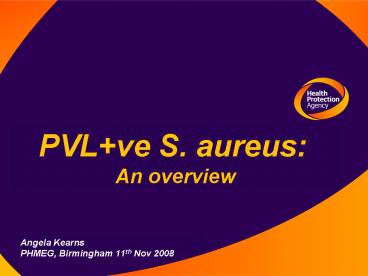PVL ve S. aureus: An overview - PowerPoint PPT Presentation
1 / 15
Title:
PVL ve S. aureus: An overview
Description:
Panton-Valentine Leukocidin. Can J Infect Dis Med Microbiol 2006;17 Suppl C; ... Day-care centres (residential & elderly) 2 siblings with abscesses treated ... – PowerPoint PPT presentation
Number of Views:878
Avg rating:5.0/5.0
Title: PVL ve S. aureus: An overview
1
PVLve S. aureus An overview
- Angela Kearns
- PHMEG, Birmingham 11th Nov 2008
2
Panton-Valentine Leukocidin
- Leukotoxin produced by S. aureus
- 2 exoproteins (LukS LukF)
Can J Infect Dis Med Microbiol 200617 Suppl C
Boyle-Vavra et al, Lab Invest 2007873
3
PVL phage mediated
- Carried by 5 different phages
- Few strains susceptible to infection
- 2-10 clinical isolates are PVL
- Community S. aureus (MSSA MRSA)
Gene 2001268195
4
USA300 Major public health
problem
Spread to Europe (UK, Germany, Austria, Denmark,
Holland etc)
58 SSTI in Emergency departments
Serious disease in paediatric patients
Multi-resistant strains
PVL-SA
Nosocomial cases transmission
57 SSI (Patel et al, Alabama)
Moran et al, NEJM 2006355666 Diep et al,
Lancet 2006367731-739
5
1st report of CA-MRSA in UK
Stacey et al, Br J Sports Med 199832153
- 5 members affected
- Large abscesses several cm diameter
- Arms, neck, back, face
- Failed to respond to ?-lactams
- Played touring team from South Pacific
- SW Pacific clone of CA-MRSA probably imported
6
PVL-SA Yearly trends
1361
1400
1200
PVL-MRSA
1000
PVL-MSSA
800
No. PVL-SA
496
600
224
400
200
0
2005
2006
2007
Year
7
Age groups and gender
250
200
150
Male
No PVL-SA
Female
100
50
0
0-16
17-40
41-60
gt61
Not
known
55
Age (years)
8
PVL-SA Clinical presentation
9
PVL-SA Epidemiology risk factors
- Close contacts, sharing personal items, skin
trauma - Households
- Sports teams rugby, wrestlers
- Military recruits
- Schools nurseries
- Day-care centres (residential elderly)
10
Recurrent infections Household
cluster
- 2 siblings with abscesses ? treated
- Recurring abscesses for gt12 months
- Each episode treated on individual basis
- ? Periorbital cellulitis due to PVL-MRSA
- Lessons learnt
- Treatment of individual alone ineffective
- Look at family history break cycle of
transmission - Effective management requires holistic approach
- Review and treat/decolonise entire family
concurrently
11
Summary
- PVL-SA major public health problem in USA
- Modest disease burden in UK rest of Europe
- Highly transmissible esp. in community
- Close contacts e.g. families, social groups
- High attack rate
- Considerable morbidity
- Young, previously healthy individuals
- Key challenge - preventing spread in the
community
12
PVL Management algorithm
Advice - Cover lesion - Practice good hygiene -
Avoid sharing personal items - Avoid work/close
contact sports
Confirmed case
Risk factors - Family history - Social
history Contact tracing - Screen close
contacts? - Treat decolonise?
ID Antibiotics
http//www.hpa.org.uk/PVL-SA_FinalGuidance.pdf
13
Burden of PVL-SA disease
- Surveillance-based studies (DH funded)
- - Asymptomatic carriage rate in community
- - Pyogenic SSTIs from AE and Walk-in
centres - - Volunteers???
14
Concerns
- Awareness timeliness of PVLve results
- ad hoc?
- Copy reports to CCDC/HPUs contact Angela
- Evidence base for guidance
- Role of PVL????
- Impact v. resource-intensive
- Consistency between HPUs (action cards)
- National effort
- Inform revision of national PVL guidance
15
When to suspect PVL?
- S. aureus (MSSA/MRSA) from a patient with
- Recurrent/multiple boils/abscess
- Necrotising skin and soft tissue infection
- Necrotising pneumonia
- NOT bacteraemias 4/244 (1.6) PVLve all
MSSAs - Susceptibility profiles highly variable
- Reliant on clinical suspicion of PVL-related
syndrome
Esp if lt40y
JAC 200760402-6































